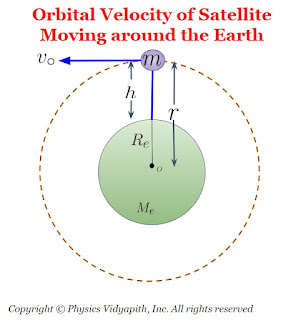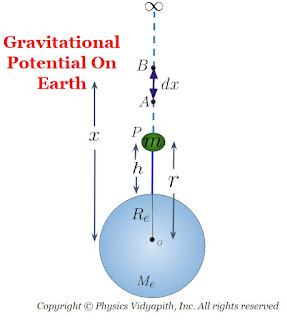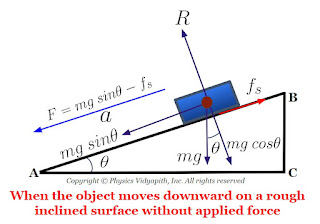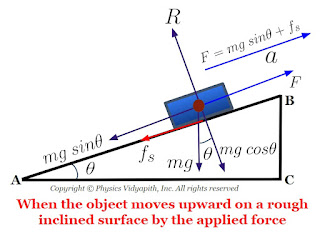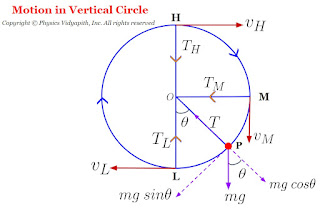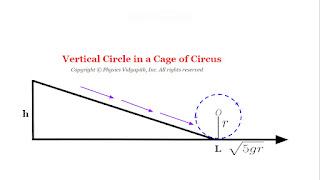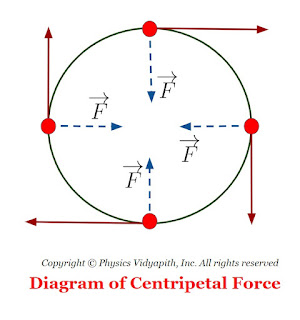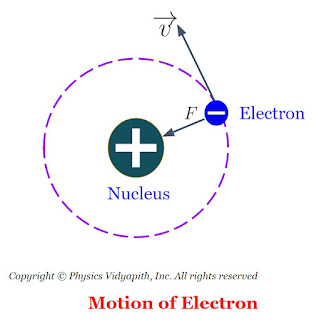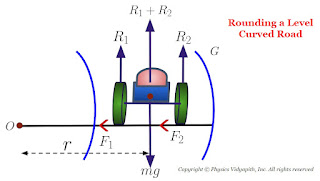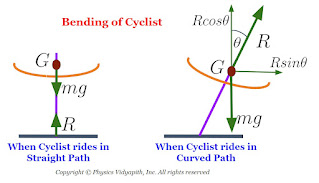Definition:
The total mechanical energy associated with an orbiting satellite around the planet is the sum of kinetic energy (i.e., due to orbital motion) and potential energy (i.e., the gravitational potential energy of the satellite).
Derivation of the total mechanical energy of the orbiting satellite around the planet:
Let us consider
The mass of the satellite = $m$
The mass of the planet = $M$
The distance between satellite to a planet from the center of the planet = $r$
The radius of planet =$R$
The potential energy of the satellite is
$U=-\frac{G \: M \: m}{r} \qquad(1)$
The kinetic energy of the satellite is
$K=\frac{1}{2}m v_{e}^{2}$
$K=\frac{1}{2} m \left[ \sqrt{\frac{G M}{r}} \right]^{2} \quad \left( \because v_{e}^{2}=\sqrt{\frac{G \: M}{r}} \right)$
$K=\frac{1}{2} \left( \frac{G M m}{r} \right) \qquad(2)$
The total energy (i.e. mechanical energy) of the satellite is
$E= K+U$
Now put the value of kinetic and potential energy from equation $(1)$ and equation $(2)$ in the above equation
$E= \frac{1}{2} \left[ \frac{G M m}{r} \right]+ \left[ -\frac{G M m}{r} \right]$
$E= -\frac{1}{2} \left[ \frac{G M m}{r} \right]$
$E= -\frac{1}{2} \left[ \frac{G M m}{R+h} \right] \left( \because r=R+h \right)$
The above equation shows that the total mechanical energy associated with orbiting satellite is negative.
The total mechanical energy associated with the orbiting satellite around the Earth:
Put $M=M_{e}$ and $R=R_{e}$ then
$E= -\frac{1}{2} \left[ \frac{G M_{e} m}{R_{e}+h} \right] \left( \because r=R_{e}+h \right)$
$E= -\frac{1}{2} \left[ \frac{g R_{e}^{2} m}{R_{e}+h} \right] \left( \because GM_{e}=g R_{e}^{2} \right)$
If the satellite revolves around near the Earth (i.e., $h=0$) then the total mechanical energy of the satellite
$E= -\frac{1}{2} \left[ \frac{g R_{e}^{2} m}{R_{e}+0} \right]$
$E= -\frac{1}{2} \left[ \frac{g R_{e}^{2} m}{R_{e}} \right]$
$E= -\frac{1}{2} \left[ g R_{e} m \right]$
Binding Energy of the Satellite:
The minimum amount of mechanical energy required to free the revolving satellite around the planet from its orbit is called the binding energy of the revolving satellite.
We know that, the revolving satellite's total mechanical energy in an orbit of the planet is
$E= -\frac{1}{2} \left[ \frac{G M m}{R+h} \right]$
At infinite distance between a satellite to a planet, the total mechanical energy of the satellite is zero. Therefore, if an orbiting satellite is provided postive energy that is equal to the total mechanical energy, its total mechanical energy becomes zero, and the satellite escapes from the planet's orbit. This total positive mechanical energy is called the gravitational binding energy of the satellite. i.e.
$E= +\frac{1}{2} \left[ \frac{G M m}{R+h} \right]$
The gravitational binding energy associated with orbiting satellite around the earth
$E= +\frac{1}{2} \left[ \frac{G M_{e} m}{R_{e}+h} \right]$
If a satellite revolves around near Earth ($h=0$), then the binding energy
$E= +\frac{1}{2} \left[ \frac{G M_{e} m}{R_{e}} \right]$
Expression for Orbital velocity of Satellite and Time Period
Orbital Velocity of Satellite:
Expression for Orbital Velocity of Satellite:
Let us consider:
The mass of the satellite = $m$
The mass of planet= $M$
The radius of Planet =$R$
The satellite is moving about the planet at height=$h$
The satellite is moving about the planet with orbital velocity=$v_{\circ}$
The distance from the center of the planet to satellite=$r$
The force of gravitation between the planet and the satellite
$F=G \frac{M \: m}{r^{2}} \qquad(1)$
This force work act as a centripetal force to revolve the satellite around the planet i.e.
$F=\frac{m v_{\circ}^{2}}{r} \qquad(2)$
From the above equation $(1)$ and equation $(2)$, we get
$\frac{m v_{\circ}^{2}}{r} = G \frac{M \: m}{r^{2}}$
$v_{\circ}= \sqrt{\frac{G \: M }{r}}$
Where $r=R+h$ then
$v_{\circ}= \sqrt{\frac{G \: M }{R+h}} \qquad(3)$
This is the equation of the orbital velocity of the satellite.
If any satellite revolves around the earth then the orbital velocity
$v_{\circ}= \sqrt{\frac{G \: M_{e} }{R_{e}+h}}$
$v_{\circ}= \sqrt{\frac{gR_{e}^{2}}{R_{e}+h}} \qquad \left( \because G \: M_{e} = gR_{e}^{2} \right)$
$v_{\circ}= R_{e} \sqrt{\frac{g}{R_{e}+h}} $
This is the equation of the orbital velocity of a satellite revolving around the earth.
If the satellite is orbiting very close to the surface of the earth ( i.e $h=0$) then the orbital velocity
$v_{\circ}= R_{e} \sqrt{\frac{g}{R_{e}+0}} $
$v_{\circ}= \sqrt{g R_{e}} $
Now subtitute the value of radius of earth (i.e $R_{e}=6.4 \times 10^{6} \: m$) and gravitational accelertaion ($g=9.8 \:m/sec^{2}$) then orbital velocity
$v_{\circ}=7.92 \: Km/sec$
The time period of Revolving Satellite:
Let us consider the time period of the revolving satellite is $T$ Then
$T= \frac{Distance \: covered \: by \: Satellite \: in \: one \: revolution}{Orbital \: Velocity}$
$T= \frac{2 \pi r}{v_{\circ}}$
$T= \frac{2 \pi \left( R+h \right)}{v_{\circ}}$
$T= \frac{2 \pi \left( R+h \right)}{v_{\circ}}$
Now subtitute the value of orbital velocity $v_{\circ}$ from equation $(3)$ in above equation then
$T= \frac{2 \pi \left( R+h \right)}{\sqrt{\frac{G \: M }{R+h}}}$
$T= 2 \pi \sqrt{ \frac{ \left( R+h \right)^{3}}{G M}}$
This is the equation of the time period of the revolution of satellites.
If a satellite revolves around the earth then the time period
$T= 2 \pi \sqrt{ \frac{ \left( R_{e}+h \right)^{3}}{G M_{e}}}$
$T= 2 \pi \sqrt{ \frac{ \left( R_{e}+h \right)^{3}}{g R_{e}^{2}}} \qquad \left( \because G \: M_{e} = gR_{e}^{2} \right)$
This is the equation of the time period of revolution of satellite revolving around the earth.
If the satellite revolves very nearly around the earth (i.e $h=0$) then the time period of the satellite from the above equation
$T= 2 \pi \sqrt{ \frac{ \left( R_{e}+0 \right)^{3}}{g R_{e}^{2}}} $
$T= 2 \pi \sqrt{ \frac{ R_{e}}{g}} $
$T= 84.6 \: min $
When any satellite moves about the planet in a particular orbit then the velocity of the satellite is called the orbital velocity of the satellite.
The time taken by satellite to complete on revolution around the planet is called the time period of the satellite.
Derivation of Gravitational Potential Energy due to Point mass and on the Earth
Definition of Gravitational Potential Energy:
$U=W_{\infty \rightarrow r}$
Derivation of Gravitational Potential energy due to a Point mass:
Let us consider,
The mass of the point object (i.e point mass)=$m$
The mass of the object that produces the gravitational field = $M$
If the point mass $m$ is at a distance $x$ then the gravitational force between the objects is
$F=G \frac{M \: m}{x^{2}} \qquad(1)$
If the point mass moves a very small distance element $dx$ that is at distance $x$ from point $O$ then the work done to move the point object from point $B$ to $A$
$dw=F.dx$
Now substitute the value of $F$ from equation $(1)$ in above equation
$dw=G \frac{M \: m}{x^{2}}.dx$
Therefore, the work done to bring the point mass from infinity to point $P$ that is at distance $r$ from point $O$ then work done to move the point object from infinity ($\infty$) to point $P$
$\int_{0}^{W} dw = \int_{\infty}^{r} G \frac{M \: m}{x^{2}}.dx $
$ [w]_{0}^{W} = G\: M\: m \int_{\infty}^{r} \frac{1}{x^{2}}.dx $
$ [W-0] = G\: M\: m [-\frac{1}{x} ]_{\infty}^{r} $
$ W = G\: M\: m [\left(-\frac{1}{r}\right) - \left(-\frac{1}{\infty}\right)]$
$ W = -\frac{G\: M\: m }{r} \qquad \left( \because \frac{1}{\infty} =0 \right)$
$ W = -\frac{G\: M\: m }{r} $
This work done by the force is stored in the form of potential energy i.e
$U=W$
$U=-\frac{G\: M\: m }{r}$
Thus the above equation represents the gravitational potential energy of an object at point $P$
Gravitational Potential Energy on Earth:
Let us consider,
The mass of Earth = $M_{e}$
The radius of earth = $R_{e}$
The mass of the object = $m$
The distance from centre $O$ of the earth to point $P$ = $r$
The distance from the surface of the earth to point $P$ = $h$
If the object is at a distance $x$ then the gravitational force is
$F=G \frac{M_{e} \: m}{x^{2}} \qquad(1)$
If the object moves a very small distance element $dx$ that is at distance $x$ from centre point $O$ of the earth then the work done to move an object from point $B$ to $A$
$dw=F.dx$
Now substitute the value of $F$ from equation $(1)$ in above equation
$dw=G \frac{M_{e} \: m}{x^{2}}.dx$
Therefore, the work done to bring the object from infinity to point $P$ that is at distance $r$ from centre point $O$ of the earth then the work done to move an object from infinity ($\infty$) to point $P$
$\int_{0}^{W} dw = \int_{\infty}^{r} G \frac{M_{e} \: m}{x^{2}}.dx $
$ [w]_{0}^{W} = G\: M_{e}\: m \int_{\infty}^{r} \frac{1}{x^{2}}.dx $
$ [W-0] = G\: M_{e}\: m [-\frac{1}{x} ]_{\infty}^{r} $
$ W = G\: M_{e}\: m [\left(-\frac{1}{r}\right) - \left(-\frac{1}{\infty}\right)]$
$ W = -\frac{G\: M_{e}\: m }{r} \qquad \left( \because \frac{1}{\infty} =0 \right)$
$ W = -\frac{G\: M_{e}\: m }{r} $
The above equaton shows that the work done by force is stored in the form of gravitational potential energy i.e.
$U=W$
$ U = -\frac{G\: M_{e}\: m }{r}$
Where $r=R_{e}+h$, then above equation can be written as
$U = -\frac{G\: M_{e}\: m }{R_{e}+h} \qquad(2)$
This is the equation of the gravitational potential energy at point $P$. The other form of the above equation i.e
$U = -\frac{g R_{e}^{2} \: m }{R_{e}+h} \qquad \left( \because GM_{e}= g R_{e}^{2} \right)$
If the object is placed on the surface of the earth then $h=0$. So gravitational potential energy on the surface of the earth
$U=-\frac{G \: M_{e} \: m}{R_{e}}$
This is the equation of the gravitational potential energy of an object placed on the surface of the earth.
$U=-\frac{g R_{e}^{2} m}{R_{e}} \qquad \left( \because GM_{e}= g R_{e}^{2} \right)$
$U=-g R_{e} m$
This is another form of the gravitational potential energy of an object placed on the surface of the earth.
Note:
We know that the gravitational potential energy at any point from above the surface of the earth
$U = -\frac{G\: M_{e}\: m }{R_{e}+h} $
$U = V m \qquad \left( \because V= -\frac{G\: M_{e}\: }{R_{e}+h} \right)$
$U = Gravitational \: Potential \times \: mass \: of \: an \: object$
When an object is brought from infinity to a point in the gravitational field then work done acquired by the gravitational force is stored in the form of potential energy which is called gravitational potential energy.Let us consider, An object of mass $m$ brought from infinity to a point in the gravitational field. If work done acquired by force is $W$ then gravitational potential energy
The mass of the point object (i.e point mass)=$m$
The mass of the object that produces the gravitational field = $M$
The radius of earth = $R_{e}$
The mass of the object = $m$
The distance from centre $O$ of the earth to point $P$ = $r$
The distance from the surface of the earth to point $P$ = $h$
$U=-\frac{G \: M_{e} \: m}{R_{e}}$
Derivation of Gravitational Potential due to Point mass and on the Earth
Definition of Gravitational Potential:
$V=-\frac{W}{m}$
Derivation of Gravitational Potential due to a Point mass:
Let us consider,
The mass of the point object (i.e point mass)=$m$
The mass of the object that produces the gravitational field = $M$
If the point mass $m$ is at a distance $x$ then the gravitational force between the objects is
$F=G \frac{M \: m}{x^{2}} \qquad(1)$
If the point mass moves a very small distance element $dx$ that is at distance $x$ from point $O$ then the work done to move the point object from point $B$ to $A$
$dw=F.dx$
Now substitute the value of $F$ from equation $(1)$ in above equation
$dw=G \frac{M \: m}{x^{2}}.dx$
Therefore, the work done to bring the point mass from infinity to point $P$ that is at distance $r$ from point $O$ then work done to move the point object from infinity ($\infty$) to point $P$
$\int_{0}^{W} dw = \int_{\infty}^{r} G \frac{M \: m}{x^{2}}.dx $
$ [w]_{0}^{W} = G\: M\: m \int_{\infty}^{r} \frac{1}{x^{2}}.dx $
$ [W-0] = G\: M\: m [-\frac{1}{x} ]_{\infty}^{r} $
$ W = G\: M\: m [\left(-\frac{1}{r}\right) - \left(-\frac{1}{\infty}\right)]$
$ W = -\frac{G\: M\: m }{r} \qquad \left( \because \frac{1}{\infty} =0 \right)$
$ W = -\frac{G\: M\: m }{r} $
$\frac{W}{m} = -\frac{G\: M }{r} $
$ V = -\frac{G\: M}{r} \qquad \left( \because V=\frac{W}{m} \right)$
$ V = -\frac{G\: M}{r}$
Thus the above equation represents the gravitational potential at point $P$
Gravitational Potential on Earth:
Let us consider,
The mass of Earth = $M_{e}$
The radius of earth = $R_{e}$
The mass of the object = $m$
The distance from centre $O$ of the earth to point $P$ = $r$
The distance from the surface of the earth to point $P$ = $h$
If the object is at a distance $x$ then the gravitational force is
$F=G \frac{M_{e} \: m}{x^{2}} \qquad(1)$
If the object moves a very small distance element $dx$ that is at distance $x$ from centre point $O$ of the earth then the work done to move an object from point $B$ to $A$
$dw=F.dx$
Now substitute the value of $F$ from equation $(1)$ in above equation
$dw=G \frac{M_{e} \: m}{x^{2}}.dx$
Therefore, the work done to bring the object from infinity to point $P$ that is at distance $r$ from centre point $O$ of the earth then the work done to move an object from infinity ($\infty$) to point $P$
$\int_{0}^{W} dw = \int_{\infty}^{r} G \frac{M_{e} \: m}{x^{2}}.dx $
$ [w]_{0}^{W} = G\: M_{e}\: m \int_{\infty}^{r} \frac{1}{x^{2}}.dx $
$ [W-0] = G\: M_{e}\: m [-\frac{1}{x} ]_{\infty}^{r} $
$ W = G\: M_{e}\: m [\left(-\frac{1}{r}\right) - \left(-\frac{1}{\infty}\right)]$
$ W = -\frac{G\: M_{e}\: m }{r} \qquad \left( \because \frac{1}{\infty} =0 \right)$
$ W = -\frac{G\: M_{e}\: m }{r} $
$\frac{W}{m} = -\frac{G\: M_{e} }{r} $
$ V = -\frac{G\: M_{e}}{r} \qquad \left( \because V=\frac{W}{m} \right)$
$ V = -\frac{G\: M_{e}}{r}$
Where $r=R_{e}+h$, then above equation can be written as
$V=-\frac{G \: M_{e}}{R_{e}+h} \qquad(2)$
This is the equation of gravitational potential at point $P$. The other form of the above equation i.e
$V=-\frac{g R_{e}^{2}}{R_{e}+h} \qquad \left( \because GM_{e}= g R_{e}^{2} \right)$
If the object is placed on the surface of the earth then $h=0$. So gravitational potential on the surface of the earth
$V=-\frac{G \: M_{e}}{R_{e}}$
This is the equation of gravitational potential on the surface of the earth. The other form of the above equation is
$V=-\frac{g R_{e}^{2}}{R_{e}} \qquad \left( \because GM_{e}= g R_{e}^{2} \right)$
$V=-g R_{e}$
When an object is brought from infinity to a point in the gravitational field then work done acquired by the gravitational force is called gravitational potential.Let us consider, An object of mass $m$ brought from infinity to a point in the gravitational field. If work done acquired by force is $W$ then gravitational potential
The mass of the point object (i.e point mass)=$m$
The mass of the object that produces the gravitational field = $M$
The radius of earth = $R_{e}$
The mass of the object = $m$
The distance from centre $O$ of the earth to point $P$ = $r$
The distance from the surface of the earth to point $P$ = $h$
Gravitational field, Intensity of Gravitational field and its expression
Definition of Gravitational Field:
Gravitational Field Intensity:
The Expression for gravitational field intensity:
Let us consider
The mass of a lighter object that experience the force = $m$
The mass of a heavy object that produces the gravitational field= $M$
The distance between the objects = $r$
The gravitational force between the objects is
$F=G\frac{M\:m}{r^{2}} \qquad(1)$
Now the force per unit mass i.e Gravitational field intensity
$E=-\frac{F}{m} \qquad (2)$
Here the negative indicates that the direction of force is opposite to $\hat{r}$
The vector form of the gravitational field intensity
$\overrightarrow{E}=-\frac{F}{m} \hat{r}$
Where $\hat{r} \left (=\frac{\overrightarrow{r}}{r} \right)$ is the unit vector along the $\overrightarrow{r}$
Now substitute the value of $F$ in the above equation $(2)$. Therefore we get,
$E=-G \frac{M\:m}{m r^{2}}$
$E=- \frac{G \: M}{r^{2}}$
The vector form of the above equation
$\overrightarrow{E}=- \frac{G \: M}{r^{2}} \hat{r}$
The region around an object in which another object experiences a gravitational force then the region of that object is called the gravitational field.
The force applied per unit mass of an object that is placed in the gravitational field is called the intensity of the gravitational field.$\overrightarrow{E}=- \frac{G \: M}{r^{2}} \hat{r}$
The mass of a lighter object that experience the force = $m$
The mass of a heavy object that produces the gravitational field= $M$
The distance between the objects = $r$
Deduction of Newton's Law of gravitation from Kepler's Law
Deduction of Newton's Law of gravitational force from Kepler's Law:
Let us consider:
The mass of a planet = $m$
The radius of the circular path of a planet=$r$
The mass of the sun = $M$
The velocity of the planet = $v$
The time of the revolution=$T$
The attraction force between the planet and the sun is achieved by the centripetal force i.e
$F=\frac{m v^{2}}{r} \qquad(1)$
The orbital velocity of the planet:
$v=\frac{Circumference \: of \: the \: circular \: path}{Time \: period}$
$v=\frac{2\pi r}{T} \qquad(2)$
From equation $(1)$ and equation $(2)$, we get
$F=\frac{m}{r} \left( \frac{2\pi r}{T} \right)^{2}$
$F=\frac{4 \pi^{2} mr}{T^{2}} \qquad(3)$
According to Kepler's third law i.e
$T^{2}=Kr^{3} \qquad(4)$
From equation$(3)$ and equation$(4)$, we get
$F=\frac{4 \pi^{2}mr}{Kr^{3}}$
$F=\frac{4 \pi^{2}}{K}\frac{mr}{r^{3}}$
$F=\frac{4 \pi^{2}}{K}\frac{m}{r^{2}} \qquad(5)$
The source of this force is the sun. So R.H.S of equation $(5)$ should be related to the sun. Since $m$ and $r$ are related to the planet. So the quantity $\frac{4 \pi^{2}}{K}$ should be related to some constant of the sun. Let $\frac{4 \pi^{2}}{K}$ be proportional to the mass of the sun. i.e
$\frac{4 \pi^{2}}{K m} \propto M$
$\frac{4 \pi^{2}}{K m} = G M $
Here $G$ is the proportionality constant and it is called the universal gravitation constant. Now substitute the $\frac{4 \pi^{2}}{K m} = G M$ in equation $(5)$. then we get
$F=G \frac{M m}{r^{2}}$
The above equation represents the force of attraction between the sun and the planet. It is also known as Newton's law of gravitational force.
The mass of a planet = $m$
The radius of the circular path of a planet=$r$
The mass of the sun = $M$
The velocity of the planet = $v$
The time of the revolution=$T$
Force of Friction | Expression for the acceleration and the work done on inclined rough surface| Advantage and Disadvantage
Definition of Friction:
The force of friction always acts in the opposite direction of the motion of the object.
The force of friction always opposes the motion of the object. So it does not help in motion.
Friction force always helps an object to be in the rest of the position. i.e If an object is in the rest of the position that is due to only frictional force.
The frictional force is act on both states of the object i.e Rest and motion.
Modern Concept of Friction:
It is now believed that frictional forces arise because of a fundamental force occurring in nature commonly known as an electric force. Every object has surface irregularities at the atomic level.
When two surfaces come in contact then the real area in contact is much smaller than the actual area of the surface. At the contact points, the distance between the particles becomes very small and as such the molecular electrical forces begin to act between the surfaces and molecular bonds are formed.
When one of the surfaces is pulled over the other, the molecular bonds are broken. As a result, the material of the objects is deformed and new bonds are formed. The successive loading and deformation processes result in loss of energy which appears in the form of heat. To compensate for the energy loss, a force is required to be applied to start the motion.
Types of forces of friction: There are two types of forces of friction
1. Force of Static Friction
2. Force of Dynamic Friction
1. Force of Static Friction:
Note: The maximum value of the force of static friction is always equal to the minimum value of force required to start the motion. Once the motion starts, the force of friction after reducing becomes such that it is sufficient to maintain uniform motion.
Due to the force of static friction between two dry and unlubricator surfaces, the maximum force is according to the following two laws:
i.) The maximum force does not normally depend upon the area of contact.
ii.) It is directly proportional to the normal reaction.
Coefficient of Static Friction:
Note: Due to dynamic friction between the dry and unlubricated surfaces the value of dynamic friction is according to the two laws:
i.) It does not depend upon the surfaces of contact.
ii.) It is equal to the maximum normal reaction force.
Coefficient of Dynamic Friction:
Angle of friction:
Let us consider, A object of mass $m$ placed on a horizontal surface. If $F$ force is applied on the object then the value of limiting friction
$F \propto R$
$F = \mu R$
$\mu=\frac{F}{R} \qquad(1.1)$
From figure in $\Delta ROS$
$tan \theta =\frac{RS}{RO}$
$tan \theta =\frac{RS}{RO}$
$tan \theta =\frac{F}{R} \qquad \left( \because RS=F \: and \: RO=R \right)$
From the equation $(1.1)$ and the above equation, We can conclude that
$\mu=tan\theta$
Angle of Repose and Angle of Sliding:
The angle of repose or angle of sliding is defined as the minimum angle of inclination of a surface with the horizontal, such that an object placed on the surface just begins to slide down.
The various forces acting on the object are shown in the figure below:
i.) Weight $mg$ of the object acting vertically downwards.
ii.) Normal Reaction $R$ acting perpendicular to inclined surface $AB$
iii.) Force of friction $f$ acting up in the inclined surface $AB$
Now from the figure apply the equilibrium condition:
$R=mg \: cos\theta \qquad(1.2)$
$f=mg \: sin\theta \qquad(1.3)$
Now divide by equation $(1.3)$ to equation $(1.2)$
$\frac{f}{R}=\frac{mg \: sin\theta}{mg \: cos\theta}$
$\frac{f}{R}=\frac{sin\theta}{cos\theta}$
$\frac{f}{R}=tan \theta$
$\frac{\mu R}{R}=tan \theta \qquad \left( \because f=\mu R \right)$
$\mu =tan \theta $
Thus the angle of friction is equal to the angle of repose.
1.) Expression for the acceleration and work done on the object moves downward on a rough inclined surface without applied force:
Let us consider, A object of mass $m$ moving sliding downward on a rough surface that is inclined at an angle $\theta$ from horizontal. If the angle $\theta$ of the inclined surface is greater than the angle of repose, the object slides down with an acceleration $a$ without any applied force.
The various forces acting on the object are shown in the figure below:
i.) Weight $mg$ of the object acting vertically downwards.
ii.) Normal Reaction $R$ acting perpendicular to inclined surface $AB$
iii.) Force of friction $f$ acting up in the inclined surface $AB$
Apply the equilibrium condition from the figure:
$R=mg \: cos\theta \qquad(1.4)$
The net force on the object moving down the inclined surface
$F=mg \: sin\theta - f \qquad(1.5)$
$F=mg \: sin\theta - \mu R $
Now substitute the value of $R$ from equation $(1.4)$ in above equation
$F=mg \: sin\theta - \mu mg \: sin \theta$
$ma=mg \left( \: sin\theta - \mu \: sin \theta \right) \qquad( F=ma)$
$a=g \left( \: sin\theta - \mu \: sin \theta \right) $
If the object is displaced the distance $S$ by the acceleration $a$ then work done by force:
$W=F.S$
$W= mg \left(\: sin\theta - \mu \: sin \theta \right). S$
2.) Expression for acceleration and work done on the object moving upward on a rough inclined surface by the applied force:
Let us consider, A object of mass $m$ moving upward on a rough inclined surface by applying the force $F$ sliding downward on a rough surface so the various forces acting on the object are shown in the figure below:
i.) Weight $mg$ of the object acting vertically downwards.
ii.) Normal Reaction $R$ acting perpendicular to inclined surface $AB$
iii.) Force of friction $f$ acting up in the inclined surface $AB$
In equilibrium condition from the figure:
$R=mg \: cos\theta \qquad(1.6)$
The net force on the object moving down the inclined surface
$F=mg \: sin\theta + f \qquad(1.7)$
$F=mg \: sin\theta + \mu R $
Now substitute the value of $R$ from equation $(1.6)$ in above equation
$F=mg \: sin\theta + \mu mg \: sin \theta$
$ma=mg \left( \: sin\theta + \mu \: sin \theta \right) \qquad( \because F=ma)$
$a=g \left( \: sin\theta + \mu \: sin \theta \right) $
If the object is displaced the distance $S$ by the force $F$ then work done by force:
$W=F.S$
$W= mg \left(\: sin\theta + \mu \: sin \theta \right). S$
3.) Expression for acceleration and work done on the object moves on a rough horizontal surface by the applied force:
Let us consider, A object is moving on a rough horizontal surface by applying the force $F$ on the object of mass $m$ and then the net force on the object from the figure below
$F-f=ma$
$F-\mu R=ma \qquad \left(\because f=\mu R \right)$
$F-\mu mg=ma \qquad \left(R=mg \right)$
$F=m \left(\mu g+a \right)$
$a=\frac{F-\mu mg}{m}$
If the object is displaced the distance $S$ by the force $F$ then work done by force:
$W=F.S$
$W= m \left(\mu g+a \right). S$
The Advantages of Friction:
The two objects will not stick to each other if there is no friction between the surface.
The parts of machinery are held together with the help of nuts and bolts but without friction, these can not be held.
A person can not walk or stand on the surface without friction.
The brakes of any vehicle will not work without friction.
It is not possible to transfer motion from one part of a machine to the other part without the help of friction.
Sandpaper is used in cleaning because this cleaning is only possible with the help of friction.
Adhesives will lose their purpose.
The Disadvantage of Friction:
Friction always opposes the relative motion between any two objects in contact. Therefore, extra energy is lost to overcome friction. Thus, friction involves the unnecessary loss of energy. This shows that the output is always less than the input.
Friction between the parts of machinery causes wears and tear. Therefore, the lifetime of the parts of the machinery reduces.
Frictional forces produce heat, which causes damage to the machinery.
Methods of Reducing friction:
By Polishing: Polishing makes the surface smoother. Therefore, friction reduces.
By Streamlining: Friction due t air is considerably reduced by streamlining the shape of the object (sharp in front) moving through the air.
By Lubrication: Oil, grease, and many other materials are used as lubricants. These lubricants fill up the irregularities of the surface making them smother. Hence, friction decreases.
By proper selection of materials.
By using ball bearings.
When an object slides over the surface of another object then each surface applies a parallel force to the other. This force is called friction force. The direction of the force of friction on every object with respect to the other is always opposite to the motion of the second object.
$F=\mu R$
Properties of Friction Force:
2. Force of Dynamic Friction
When the friction forces acting between two surfaces at rest with respect to each other are called the force of static friction.
ii.) It is directly proportional to the normal reaction.
The ratio of the maximum value of force in static friction and normal reaction is called the coefficient of static friction.
$\mu_{s}=\frac{F}{R}$
2. Force of Dynamic Friction: When the force of friction acting between the two surfaces in relative motion is called the force of dynamic friction.
ii.) It is equal to the maximum normal reaction force.
The ratio of force in dynamic friction and normal reaction is called the coefficient of dynamic friction.
$\mu_{k}=\frac{F}{R}$
Limiting friction:
It is the maximum value of friction that acts when the object just begins to move is called Limiting Friction. The limiting friction is directly proportional to the normal reaction in the object. i.e$F \propto R$$F = \mu R$
The angle between the effective resistance $S$ (i.e resultant of frictional force and normal reaction) and normal reaction $R$ is called the angle of friction.
ii.) Normal Reaction $R$ acting perpendicular to inclined surface $AB$
iii.) Force of friction $f$ acting up in the inclined surface $AB$
ii.) Normal Reaction $R$ acting perpendicular to inclined surface $AB$
iii.) Force of friction $f$ acting up in the inclined surface $AB$
ii.) Normal Reaction $R$ acting perpendicular to inclined surface $AB$
iii.) Force of friction $f$ acting up in the inclined surface $AB$
Motion of body in a vertical circle and its Practical Applications
Calculation of Motion of a body in a vertical Circle: Let us consider, A body that has mass $m$ moving in a vertical circle of radius $r$. If at any instant the body is at position $P$ with angular displacement $\theta$ from the lower position $L$ of the circle. As shown in the figure below.
The various forces acting on the body are:
The weight $mg$ of the body, acting vertically downwards
Tension $T$in the string acting along the $PO$. Now $mg$ can be resolved into two components:
1.) The horizontal component $mg cos\theta$ opposite to $T$
2.) The vertical component $mg sin\theta$ act along tangent to the circle at $P$
So the net force on the body at position $P$ provides the necessary centripetal force required by the body
$T-mg cos\theta = \frac{m v^{2}}{r}$
$T= \frac{m v^{2}}{r} + mg \: cos\theta \qquad(1)$
Tension and velocity at the highest position $H$ of the verticle circle: At the highest position $H$ the tension $T_{H}$ of the will be minimum and the velocity $v_{H}$ will also be minimum.
If $cos\theta = -1$ i.e. $\theta=180^{\circ}$
Then Tension $T$ and velocity $v$ will be minimum i.e $T_{H}$ and $v_{H}$
so from equation $(1)$
$T_{H}= \frac{m v_{H}^{2}}{r} - mg $
So from the above equation, we can conclude that The body will move along the vertical circle only when $T_{H} \geq 0$
$\left( \frac{m v_{H}^{2}}{r} - mg \right) \geq 0$
$ \frac{m v_{H}^{2}}{r} \geq mg $
$ \frac{ v_{H}^{2}}{r} \geq g $
$ v_{H} \geq \sqrt {rg} $
Thus the minimum value of the velocity at the highest position is $\sqrt{rg}$
Tension and velocity at lowest position $L$ of the verticle circle: At the lowest position $L$ the tension and velocity will be maximum. Now applying the principle of energy conservation for the position $H$ and $L$ of the body.
Total energy at $L$ =Total energy at $H$
$\frac{1}{2}m v_{L}^{2}=\frac{1}{2}m v_{H}^{2} +mg(2r)$
Now substitute the value of $v_{H} \geq \sqrt{gr}$ in above equation then we get
$\frac{1}{2}m v_{L}^{2}=\frac{1}{2}m (gr) +mg(2r)$
$\frac{1}{2}m v_{L}^{2}=\frac{5mgr}{2}$
$v_{L} \geq \sqrt{5gr}$
For the maximum value of tension $T_{L}$ at the lowest position $L$ of the vertical circle. Now put $cos \theta =1$ i.e $\theta=0^{\circ}$ in the equation $(1)$ then we get
$T_{L}= \frac{m v_{L}^{2}}{r} + mg $
Now substitute the value of $v_{L} \geq \sqrt{5gr}$ in the above equation then
$T_{L} \geq \frac{m 5gr}{r} + mg $
$T_{L} \geq 6gr$
Tension and velocity at horizontal position $M$ of the verticle circle:
Now apply the principle of conservation of energy for position $M$ and position $L$
Total energy at $M$ =Total energy at $L$
$ \frac{1}{2}m v_{M}^{2} + mgr = \frac{1}{2} m v_{L}^{2}$
$ \frac{1}{2}m v_{M}^{2} = \frac{1}{2} m v_{L}^{2} - mgr$
Now substitute the value of $v_{L} \geq \sqrt{5gr}$ in the above equation then
$ \frac{1}{2}m v_{M}^{2} \geq \frac{1}{2} m 5gr - mgr$
$ \frac{1}{2}m v_{M}^{2} \geq \frac{3 mgr}{2}$
$v_{M}^{2} \geq 3 gr$
$v_{M} \geq \sqrt{3 gr}$
To find the tension $T_{M}$ at position $M$ substitute the $cos \theta =0$ i.e $\theta =90^{\circ}$ in equation $(1)$. Then we get
$T_{M} = \frac{m v_{M}^{2}}{r} + 0$
$T_{M} = \frac{m v_{M}^{2}}{r}$
Now substitute the value of $v_{M} \geq \sqrt{3gr}$ in the above equation. Then we get
$T_{M} \geq 3mg$
Practical Application of motion in a vertical Circle:
1.) When a bucket containing water is rotated in a vertical circle with a velocity at the lowest point $v_{L} \geq \sqrt{5gr}$, water shall not spill even at the highest point, when the bucket is upside down. If the bucket is whirled slowly, so that $ \left(mg \gt \frac{mv_{H}^{2}}{r} \right) $, then a part of the weight shall provide the necessary centripetal force $\left( \frac{mv_{H}^{2}}{r} \right)$; and the rest of the weight of water $\left( mg - \frac{mv_{H}^{2}}{r} \right) $ causes some water to accelerate downwards and spill. Only this much water shall leave the bucket.
2.) A pilot of an aircraft can successfully loop a vertical loop without falling at the top of the loop (being without a belt) when its velocity at the bottom of the loop is $\geq \sqrt{5gr}$
3.) In a circus, a motorcyclist is able to perform the feat of driving the motorcycle along a vertical circle in a cage. The motorcyclist does not fall even at the highest point, when his velocity at the bottom of the cage is $\geq \sqrt{5gr}$.
To acquire this velocity at the lowest point $L$ of the vertical circle of radius $r$, he has to roll down a vertical height $h$, As shown in the figure below:
From the equation of motion $v^{2}=u^{2}+2as$
Let $u=0$, $a=+g$ and $s=h$
we get, $v^{2}=0 +2gh$
$v=\sqrt{2gh}$
To move in a vertical circle, the velocity $v$ acquired at $L$ must at least be equal to $\sqrt{5gr}$. i.e.
$\sqrt{2gh}= \sqrt{5gr}$
$h=\frac{5r}{2}$
Definition of work done and its essential condition
Work: When a force is applied on a body and a body is displaced along the line of action of force then this is called the work done by force. Work is a scalar quantity.
Unit: $Joule$, $N-m$
Dimension: $[ML^{2}T^{-2}]$
Example: When a boy kicks a football to move it, the boy is said to have done some work.
Let us consider, A body that has mass $m$. If a force $F$ applied on a body at an angle $\theta$ and body is displaced from position $A$ to position $B$ with distance $d$ then work done by force:
$W= horizontal \: component \: of \: the \: force \times displacement $
$W=F\:cos\theta \times d$
$W=F d\:cos\theta \qquad(1)$
$W=\overrightarrow{F}. \overrightarrow{d}$
So, we can conclude from the above equation that "The work done by the force is the scalar product of the force and displacement ".
Note: When the force is applied at an angle $\theta$ then the vertical component of the force is balanced by weight $mg$ and the horizontal component of the force is responsible for the motion of the body.
Essential Condition for work to be done:
For work to be done, the following two conditions should be satisfied
A force should act on the body.
The body should move in the direction of the force, or opposite to it, i.e the point of application of the force should move in the direction of the force or opposite to it. In other words, the body must be displaced
Types of Work done by force:
Positive Work done
Zero Work done
Negative Work done
Positive Work done: When a force is applied on a body and the body is displaced along in direction of the force then this is called the positive work done by force.
If $\theta=0 ^{\circ}$, then $cos0 ^{\circ} =1$
the from equation $(1)$
So Work done by force
$W=Fd$
Zero Work done: When a force is applied on a body and the body is not displaced from its position then this is called the zero work done by force.
If $\theta=90 ^{\circ}$, then $cos90 ^{\circ} =0$
then from equation $(1)$
So Work done by force
$W=0$
Negative Work done: When a force is applied on the body and a body is displaced along in the opposite direction of the force then this is called the negative work done by force.
If $\theta=180^{\circ}$, then $cos 0^{\circ} =-1$
then from equation $(1)$
So Work done by force
$W=-Fd$
** 1 Joule Work done: When $1 \: Newton$ of force is applied on a body and a body is displaced by $1\: m$ along the line of action of force then this is called the $1 \: Joule$ work done by force.**
Principle and Proof of Law of Conservation of Energy
Law of Conservation of Energy: According to this principle
Proof of Conservation's Law of Energy: Let us consider, A particle is freely falling from height $h$ under the gravitational acceleration $g$. So the total energy of the particle at different points :
Calculation of Total Energy at Point $A$:
The initial velocity of the particle at point $A$ is $(v_{A})=0$
The kinetic energy of the particle at point $A$ is $(K_{A})=\frac{1}{2}mv_{A}^{2}$
$K_{A}=0\qquad \left( \because v_{A}=0 \right)$
The potential energy of the particle at point $A$ is $(U_{A})=mgh$
The total energy of a particle at point $A$ is $(E_{A})=K_{A}+U_{A}$
Now substitute the value of $K_{A}$ and $U_{A}$ in the above equation. Now the above equation can be written as:
$E_{A}=0+mgh$
$E_{A}=mgh \qquad(1)$
Calculation of Total Energy at Point $B$: If a particle travels the distance $x$ and reaches point $B$ then velocity at point $B$ can be calculated by the equation of motion. i.e.
$v_{B}^{2}=v_{A}^{2}+2gx$
But the initial velocity of the particle is zero. i.e $v_{A}=0$ then the above equation can be written as
$v_{B}^{2}=0+2gx$
$v_{B}^{2}=2gx$
The kinetic energy of the particle at point $B$ is $(K_{B})=\frac{1}{2}mv_{B}^{2}$
Now substitute the value of $v_{B}^{2}$ in the above equation. Now the above equation can be written as:
$K_{B}=\frac{1}{2}m \left( 2g x \right)$
$K_{B}=mgx $
The height of the particle at point $B$ is $(h-x)$ then the potential energy at point $B$ is $(U_{B})=mg(h-x)$
The total energy of a particle at point $B$ is $(E_{B})=K_{B}+U_{B}$
Now substitute the value of $K_{B}$ and $U_{B}$ in the above equation. Now the above equation can be written as:
$E_{B}=mgx+mg(h-x)$
$E_{B}=mgh \qquad(2)$
Calculation of Total Energy at Point $C$: Now the particle reaches point $C$ by traveling distance $h$ from the initial point $A$. This point $C$ is just before the collision from the surface. So the velocity of the particle at point $C$.
$v_{C}^{2}= v_{A}^{2}+2gh$
$v_{C}^{2}= 0+2gh \qquad \left( v_{A}=0 \right)$
$v_{C}^{2}= 2gh$
The kinetic energy of the particle at point $C$ is $(K_{C})=\frac{1}{2}mv_{C}^{2}$
Now substitute the value of $v_{C}^{2}$ in the above equation. Now the above equation can be written as:
$K_{C}=\frac{1}{2}(2mgh)$
$K_{C}=mgh$
At point $C$ the particle is just above the surface so the height $h$ of the object will be zero. i.e. $h=0$
The potential energy at point $C$ is $(U_{C})=0$
The total energy of the particle at point $C$ is $(E_{C})=K_{C}+U_{C}$
Now substitute the value of $K_{C}$ and $U_{C}$ in the above equation. Now the above equation can be written as:
$E_{C}=mgh+0$
$E_{C}=mgh \qquad(3)$
From the above equation $(1)$, equation $(2)$ and equation $(3)$, we get
$E_{A}=E_{B}=E_{C}$
Now we can conclude that the total energy of the particle is always conserved when there is no external influence applied. This is proof of the law of conservation of Energy.
The energy is neither created nor destroyed. The energy can be changed from one form to another form. i.e. when there is not any external influence is applied on the particle then the total energy of the particle is always conserved.
Definition and Practical Applications of Centripetal Force
Definition of Centripetal Force:
This force is also known as a radial force because the direction of force is toward the centre of the circle.
Let us consider, A particle of mass $m$ moving around a circular path of radius $r$ with linear velocity $v$. So the force on a particle:
$F=ma$
Where $a$ is centripetal acceleration i.e. $a=\frac{v^{2}}{r}$. So the force on a particle can be written as
$F=m\frac{v^{2}}{r}$
$F=\frac{mv^{2}}{r}$
$F=m\frac{(r \omega)^{2}}{r} \qquad \left( \because v=r \omega \right)$
$F=mr\omega^{2}$
$F=mr\left(\frac{2\pi}{T}\right)^{2} \qquad \left( \because \omega=\frac{2\pi}{T} \right)$
$F=mr\frac{4\pi^{2}}{T^{2}}$
$F= \frac{4 \pi^{2} m r}{T^{2}} $
$F=4 \pi^{2} m r n^{2} \qquad \left( \because n=\frac{1}{T} \right)$
Practical Applications of Centripetal Force:
1. The planets revolve around the sun and the necessary centripetal force is achieved by gravitational force between the sun and the planet. as shown in the figure below
2. The electrons revolve around the nucleus of the atom and the necessary centripetal force is achieved by the force of attraction on the revolving electrons and protons in the nucleus. as shown in the figure below
3. In this case, When a piece of stone is tied to the end of a string whose other end is held in the hand then the required centripetal force, to revolve the stone in a circular path, is achieved by the tension of the string.
4. When a motor car is moving in a curved path then the necessary centripetal force is achieved by friction between the wheels and the road.
5. Rounding a Level Curve Road:
When a vehicle goes in round a curved road, it requires some centripetal force. While rounding the curve, the wheels of the vehicle have a tendency to leave the curved path and regain the straight line path. The force of friction between the wheels and the road opposes this tendency of the wheels. This frictional force acts towards the centre of the circular track and provides the required centripetal force.
The forces acting on moving vehicles on the curved road are
Weight $mg$ of the vehicle act vertically downward
Normal reaction $R_{1}$ and $R_{2}$ from both sides of the wheels act vertically upward from the horizontal surface
The frictional force $F_{1}$ and $F_{2}$ from both sides of wheels of the vehicle
Hence, the centripetal force is provided by friction force only, therefore
$\frac{mv^{2}}{r} \leq F_{1}+F_{2}$
Where $F_{1}=\mu R_{1}$ and $F_{2}=\mu R_{2}$, then
$\frac{mv^{2}}{r} \leq \mu R_{1}+\mu R_{2}$
$\frac{mv^{2}}{r} \leq \mu \left( R_{1}+ R_{2} \right)$
$\frac{mv^{2}}{r} \leq \mu R \qquad \left( R= R_{1}+ R_{2} \right)$
$\frac{mv^{2}}{r} \leq \mu mg \qquad \left(R=mg \right)$
$\frac{v^{2}}{r} \leq \mu g $
$v^{2} \leq \mu r g$
$v \leq \sqrt{\mu r g}$
Here, $\mu$ is the frictional coefficient.
This is the maximum velocity of the vehicle for rounding on a level curved road without sliding. But the value is very low as it depends on the friction coefficient.
6. Banking of roads: The phenomenon of raising the outer age of the curved road above the inner age is called the banking of roads.
When a vehicle moves on the curved path at a reasonable speed without slipping then sufficient centripetal force is required to move in a curved path which is achieved by banking of the road.
In the case of the Banking of roads, The centripetal force is not provided by friction between the wheels and the road.
Calculation of the angle of banking:
Let us consider, A vehicle of mass $m$ moving around the curved path of radius $r$ with velocity $v$ on a road banking through an angle $\theta$. The forces applying to the vehicle are:
A.) The weight $mg$ act vertically downward.
B.) Normal reaction $R$ of the ground acts perpendicular to the banked road and can be resolved into two components. i.e. Verticle component $R sin\theta$ and Horizontal component $R cos\theta$.
C.) The horizontal component $R cos\theta$ is balanced by the weight $mg$ of the vehicle. i.e.
$R cos\theta= mg \qquad (1)$.
D.) The vertical component of normal reaction $R sin\theta$ acts along the horizontal towards the centre of the circular path and it provides the centripetal force. i.e.
$R sin\theta=\frac{mv^{2}}{r} \qquad (2)$
Now divide equation $(2)$ and equation $(1)$
$\frac{R sin\theta}{R cos\theta}= \frac{\frac{mv^{2}}{r}}{mg}$
$\frac{ sin\theta}{ cos\theta}=\frac{v^{2}}{rg} $
$ tan\theta=\frac{v^{2}}{rg} \qquad(3)$
If $h$ is the height $AB$ of the outer edge of the road above the inner edge and $b$ is the breadth $OB$ of the road then from the figure:
$OA=\sqrt {(OB)^{2}-(AB)^{2}}$
$OA=\sqrt {b^{2}-h^{2}}$
$tan\theta=\frac{AB}{OA}$
$tan\theta=\frac{h}{\sqrt {b^{2}-h^{2}}} \qquad (4)$
From equation $(3)$ and equation $(4)$
$tan\theta=\frac{v^{2}}{rg}=\frac{h}{\sqrt {b^{2}-h^{2}}}$
From the above equation, we can calculate $h$. Usually $h << b$. Therefore, $h^{2}$ is negligibly small compared to $b^{2}$. The above equation can be written as:
$tan\theta=\frac{v^{2}}{rg}=\frac{h}{b}$
Roads are usually banked for the average speed of the vehicle passing over them. However, If the speed of a vehicle is somewhat less or more than this, the self-adjusting static friction will operate between the tyres and the road, and the Vehicle will not skid.
7. Bending of Cyclist: When a cyclist takes a turn on the curved path then the cyclist has to bend the cycle a little inwards from his vertical position to achieve the necessary centripetal force.
Calculation of the angle of bending:
Let us consider, The cyclist of mass $m$ moving around the curved path of radius $r$ with velocity $V$. The force acting on the cyclist:
A.) The weight $mg$ act vertically downward.
B.) Normal reaction $R$ of the ground act on the cyclist at an angle $\theta$ with the verticle and can be resolved into two components. i.e. Verticle component $R sin\theta$ and Horizontal component $R cos\theta$.
C.) The horizontal component $R cos\theta$ is balanced by the weight $mg$ of the cyclist. i.e.
$R cos\theta= mg \qquad (1)$.
D.) The vertical component $R sin\theta$ acts along the horizontal towards the centre of the circular path and it provides the centripetal force. i.e.
$R sin\theta=\frac{mv^{2}}{r} \qquad (2)$
Now divide equation $(2)$ and equation $(1)$
$\frac{R sin\theta}{R cos\theta}= \frac{\frac{mv^{2}}{r}}{mg}$
$\frac{ sin\theta}{ cos\theta}=\frac{v^{2}}{gr}$
$ tan\theta=\frac{v^{2}}{gr}$
$ \theta=tan ^{-1} \left( \frac{v^{2}}{gr} \right)$
When a particle moves in a circular path then a force act, toward the centre of the circle, on a particle. This type of force is called the centripetal force.
| $ \theta=tan ^{-1} \left( \frac{v^{2}}{gr} \right)$ |
Definition and Derivation of Centripetal Acceleration
Definition:
Derivation of Centripetal Acceleration: Let us consider, A particle that has mass $m$ moving with velocity $v$ in a circular path of radius $r$.
If a particle is moving from point $P_{1}$ to point $P_{2}$ by covering distance $\Delta s$ on the circumference of the circle by making an angular displacement of $\theta$ at the center $O$ of the circle.
The direction of velocity of the particle at point $P_{1}$ and $P_{2}$ is $\overrightarrow{v_{1}}$ and $v_{2}$.
Now take the change in velocity from point $P_{1}$ to $P_{2}$ by vector subtraction method as shown in figure below:
To find the expression for the centripetal acceleration, Now take two similar triangles $\Delta OP_{1}P_{2}$ and $\Delta ABC$ from the figure:
$\frac{OP_{1}}{AB}=\frac{P_{1}P_{2}}{BC}$
Now substitute the values from the figure in the above equation i.e.
$\frac{r}{v}=\frac{\Delta s}{\Delta v}$
$\Delta v = \frac{v}{r} \Delta s $
Now divide by $\Delta t$ into both sides the above equation can be written as
$\frac{\Delta v}{\Delta t}=\frac{v}{r} \frac{\Delta s}{\Delta t}$
If $\Delta t$ is tends to zero i.e. $\Delta t \rightarrow 0$ then
$\underset{\Delta t \rightarrow 0}{Lim} \: \frac{\Delta v}{\Delta t}=\frac{v}{r} \: \underset{\Delta t \rightarrow 0}{Lim} \: \frac{\Delta s}{\Delta t}$
Where
$\underset{\Delta t \rightarrow 0}{Lim} \: \frac{\Delta v}{\Delta t} \rightarrow$ Instantaneous Acceleration. It is also known as Centripetal Acceleration $(a)$
$\underset{\Delta t \rightarrow 0}{Lim} \: \frac{\Delta s}{\Delta t} \rightarrow$ Instantaneous Velocity $(v)$
Now the above equation can be written as
$a = \frac{v^{2}}{r} $
$a = \frac{(r\omega)^{2}}{r} \quad \left( \because v=r\omega \right)$
$a = r \omega ^{2} $
When a particle moves in a circular path then acceleration act on the particle which has a direction toward the center of the circle. This acceleration is called centripetal acceleration.
$\underset{\Delta t \rightarrow 0}{Lim} \: \frac{\Delta v}{\Delta t} \rightarrow$ Instantaneous Acceleration. It is also known as Centripetal Acceleration $(a)$
Relation between angular acceleration and linear acceleration
Equation for the relation between linear acceleration and angular acceleration:
Deduce the equation from the General Method:
We know that angular acceleration is
$\alpha=\frac{\Delta \omega}{\Delta t} \qquad (1)$
$\alpha=\frac{\Delta (v/r)}{\Delta t} \qquad \left( \because \omega=\frac{v}{r} \right)$
$\alpha=\frac{1}{r} \frac{\Delta v}{\Delta t}$
If $\Delta t \rightarrow 0$, then the above equation can be written as
$\alpha=\frac{1}{r} \: \underset{\Delta t \rightarrow 0}{Lim} \frac{\Delta v}{\Delta t}$
Where
$\underset{\Delta t \rightarrow 0}{Lim} \: \frac{\Delta v}{\Delta t} \rightarrow$ Instantaneous Acceleration $(a)$
$\alpha=\frac{a}{r}$
Deduce the equation from the Differential Method
We know that angular acceleration is
$\alpha=\frac{d \omega}{dt} \qquad (1)$
$\alpha=\frac{d (v/r)}{dt} \qquad \left( \because \omega=\frac{v}{r} \right)$
$\alpha=\frac{1}{r} \frac{dv}{dt} \qquad (2)$
Where
$\frac{dv}{dt}$ = Instantaneous Acceleration $(a)$
Now equation $(2)$ can be written as
$\alpha=\frac{a}{r}$
$\underset{\Delta t \rightarrow 0}{Lim} \: \frac{\Delta v}{\Delta t} \rightarrow$ Instantaneous Acceleration $(a)$
$\frac{dv}{dt}$ = Instantaneous Acceleration $(a)$
Popular Posts
-
Let $S$ be a point monochromatic source of light of wavelength $\lambda$ placed at the focus of collimating lens $L_{1}$. The light beam is ...
-
Angle of Acceptance → "If incident angle of light on the core for which the incident angle on the core-cladding interface equals t...
-
Derivation of interference of light due to a wedge-shaped thin film: Interference of light due to wedge-shaped thin film The wedge...
-
Maxwell's Equations: Maxwell's equation of the electromagnetic wave is a collection of four equations i.e. Gauss's law of elec...
-
Let a plane wavefront be incident normally on slit $S_{1}$ and $S_{2}$ of equal $e$ and separated by an opaque distance $d$.The diffracted l...
Study-Material
Categories
Alternating Current Circuits
(10)
Atomic and Molecular Physics
(4)
Biomedical
(1)
Capacitors
(6)
Classical Mechanics
(12)
Current carrying loop in magnetic field
(5)
Current Electricity
(10)
Dielectric Materials
(1)
Electromagnetic Induction
(3)
Electromagnetic Wave Theory
(23)
Electrostatic
(22)
Energy Science and Engineering
(2)
Error and Measurement
(2)
Gravitation
(11)
Heat and Thermodynamics
(3)
Kinematics Theory Of Gases
(2)
Laser System & Application
(15)
Magnetic Effect of Current
(9)
Magnetic Substances
(3)
Mechanical Properties of Fluids
(4)
Nanoscience & Nanotechnology
(4)
Nuclear Physics
(7)
Numerical Problems and Solutions
(2)
Optical Fibre
(5)
Optics
(25)
Photoelectric Effect
(3)
Quantum Mechanics
(34)
Relativity
(8)
Semiconductors
(2)
Superconductors
(1)
Topic wise MCQ
(9)
Units and Dimensions
(1)
Waves
(5)

